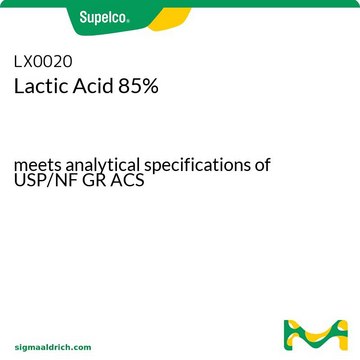W261114
Lactic acid
natural, ≥85%
Synonym(s):
DL-Lactic acid, 2-Hydroxypropionic acid
About This Item
Halal
Kosher
natural
Recommended Products
grade
Fragrance grade
Halal
Kosher
natural
Agency
follows IFRA guidelines
reg. compliance
EU Regulation 1223/2009
FDA 21 CFR 117
Assay
≥85%
form
liquid
greener alternative product characteristics
Less Hazardous Chemical Syntheses
Use of Renewable Feedstocks
Learn more about the Principles of Green Chemistry.
sustainability
Greener Alternative Product
refractive index
n20/D 1.425 (lit.)
pH
2
bp
122 °C/15 mmHg (lit.)
density
1.209 g/mL at 25 °C (lit.)
cation traces
As: ≤3 ppm
Cd: ≤1 ppm
Fe: ≤10.0 ppm
Hg: ≤1 ppm
Pb: ≤10 ppm
application(s)
flavors and fragrances
Documentation
see Safety & Documentation for available documents
food allergen
no known allergens
fragrance allergen
no known allergens
greener alternative category
, Aligned
Organoleptic
odorless
SMILES string
CC(O)C(O)=O
InChI
1S/C3H6O3/c1-2(4)3(5)6/h2,4H,1H3,(H,5,6)
InChI key
JVTAAEKCZFNVCJ-UHFFFAOYSA-N
Looking for similar products? Visit Product Comparison Guide
Related Categories
General description
Disclaimer
Signal Word
Danger
Hazard Statements
Precautionary Statements
Hazard Classifications
Eye Dam. 1 - Skin Corr. 1C
Supplementary Hazards
Storage Class Code
8A - Combustible corrosive hazardous materials
WGK
WGK 1
Flash Point(F)
235.4 °F - closed cup
Flash Point(C)
113 °C - closed cup
Personal Protective Equipment
Choose from one of the most recent versions:
Already Own This Product?
Find documentation for the products that you have recently purchased in the Document Library.
Customers Also Viewed
Global Trade Item Number
| SKU | GTIN |
|---|---|
| W261114-5KG | |
| W261114-SAMPLE | |
| W261114-10KG | |
| W261114-10KG-K | 4061838257130 |
| W261114-1KG-K | 4061838257147 |
| W261114-5KG-K | 4061838180568 |
| W261114-SAMPLE-K | 4061837515620 |
Our team of scientists has experience in all areas of research including Life Science, Material Science, Chemical Synthesis, Chromatography, Analytical and many others.
Contact Technical Service





